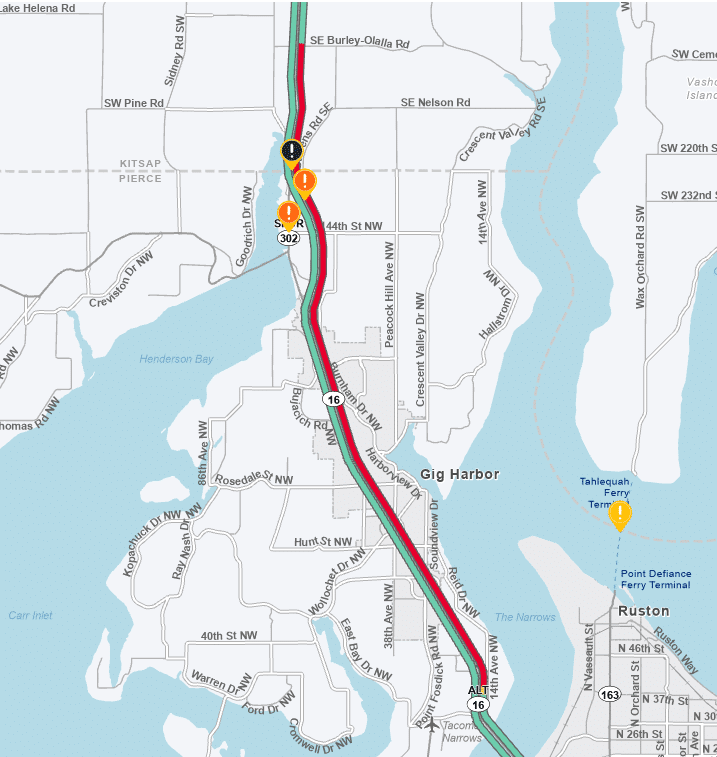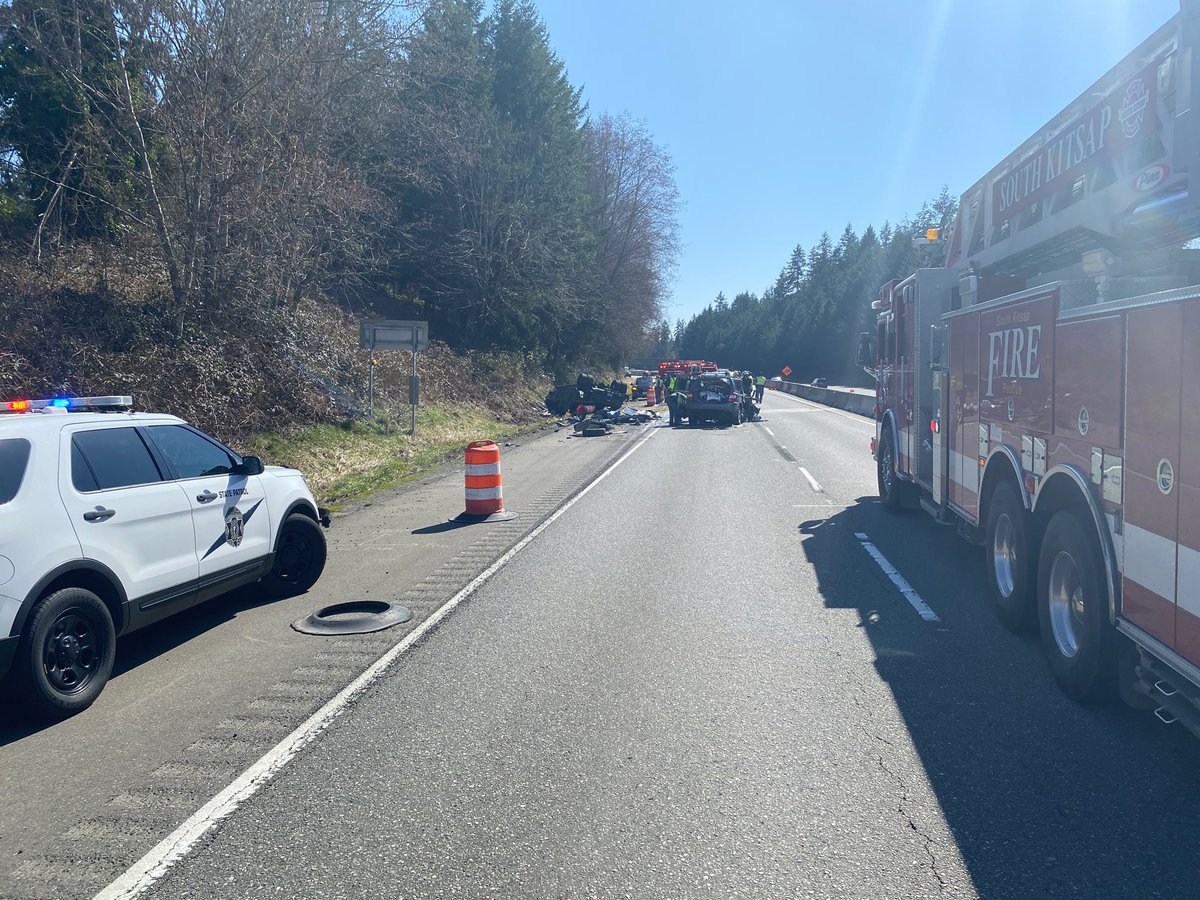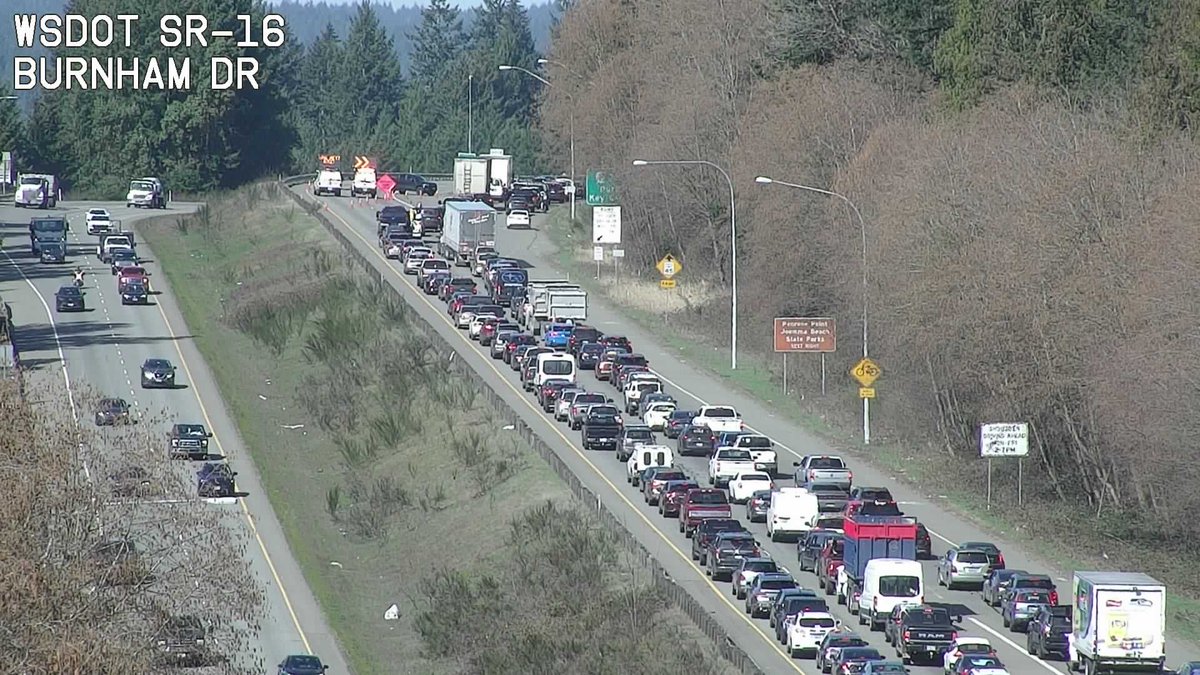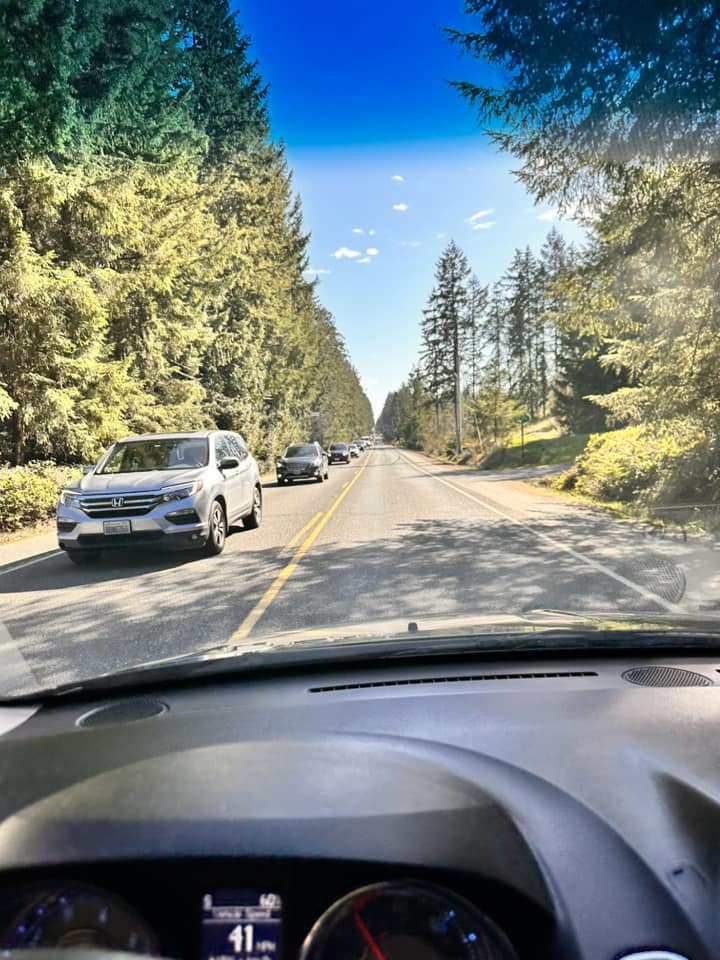Community Police & Fire Transportation
Highway 16 crashes paralyze Gig Harbor streets
A wrong-way-driver crash brought Highway 16 and Gig Harbor-area surface streets to a standstill last week. While an extreme case, the event spotlighted how vulnerable local roads are to disruption.
At about 1 p.m. on March 22, a man raced eastbound down the right westbound shoulder of Highway 16 near the Pierce-Kitsap county line, according to a State Patrol report. He swerved the large, stolen pickup truck into the right lane and struck a SUV head-on.
The Ford F-350 wound up on its top in the ditch. The driver crawled out and ran into the woods. He hasn’t been caught.
The Toyota Highlander stopped in the road. The 74-year-old male driver and 73-year-old female passenger, both of Gig Harbor, were taken to St. Joseph’s Hospital in Tacoma. The woman was in serious condition with several broken bones and cuts. The man suffered blunt force chest trauma, according to their daughter.
Westbound highway closed for six hours
Westbound Highway 16 was closed for six hours, with traffic diverted around the scene through Purdy via Highway 302.
Highway 16 traffic immediately began backing up, ultimately stretching across the Tacoma Narrows Bridge. Soon, limited side-road alternatives became jammed.
Traffic maps screens showed a web of red, signifying stop-and-go driving. Mostly stop. Drivers reported taking as long as two hours to traverse the few miles.

This WSDOT map from March 22 shows Highway 16 traffic backed up from Kitsap County to the Tacoma Narrows Bridge. If it was enlarged, most of the side streets would also be red, signifying stop-and-go traffic.
For non-injury or minor-injury collisions, state troopers can move vehicles to the side and relatively quickly restore flow, though the frequent crashes still can clog side roads as drivers seek open asphalt.
Circumstances on March 22 prevented a quick reopening.
Why it took so long to reopen
“WB SR 16 was shut down for almost 6 hours because any time there is a serious injury/fatal we have to do an extensive investigation,” State Patrol spokeswoman Katherine Weatherwax explained in an email. “We close the roadway so we can recover evidence and do our investigation, which takes a while under more normal circumstances. Also due to potential felony charges a detective has to come out as well. In this case we had more variables, looking for a suspect. Also removing the vehicle in this case took a long time.”
The crime scene must be precisely measured by collision technicians and drones, State Patrol spokesman Robert Reyer said in a phone interview. That work took up the entire roadway.
“It’s important for us to do our due diligence for the victim of this crime and the family of the victim to have everything done properly and meticulously to allow for a successful prosecution,” Reyer said. “We do our best to be as quick as we can while maintaining the highest level of thoroughness. We don’t want to rush through it and miss important pieces of information or by not measuring everything the best we can.
“I try to explain if this was your family member or somebody you are close to, you would want us to do the most thorough investigation we can do? That usually changes people’s opinions about being stuck in traffic.”
After investigation comes clean-up
Only after the investigation can tow truck drivers and state Transportation Department crews move in and remove vehicles and clean up debris and fluid spills.
“WSDOT can pre-stage maintenance crews to assist with the clean-up, but we don’t start our work until law enforcement has completed their investigation,” spokeswoman Cara Mitchell said in an email. “We, along with WSP, are doing everything we can to expedite getting the lanes reopened. Depending on the circumstances of the collision, that timeline is going to vary.”
Geography and infrastructure factor into the gridlock. There’s only one way on and off the peninsula to the south. Highway 16 carries 92,000 vehicles across the Tacoma Narrows Bridge each day and more than 75,000 past Purdy. Crashes send drivers meandering along slower county and city roads that aren’t designed for highway traffic.
On the west side, drivers eventually are pinched back to the highway by Henderson Bay. There’s no getting around it. On the east, they’re forced through downtown Gig Harbor’s 25 mph or 35 mph streets.
It’s a matter of whether they can get past the collision and how many others have the same idea.
“Traffic like this is unique to our area because there is only one way in and one way out unless you drive all the way around to SR 101 to SR 3, which in this case might have been faster than taking the side roads,” WSDOT’s Mitchell said of a long route through Olympia and Shelton.
Avoid if possible, be prepared if not
Highway 16 crashes will continue to happen, and not just at the notorious Wollochet Drive onramps but all along the corridor. The state has no concrete plans for improvements, though some were mentioned in a 2018 congestion study. Residents, however, can reduce their exposure by being prepared.
Know before you go. Several services provide traffic information. PulsePoint is a 911-connected mobile app that allows users to receive alerts on calls being responded to by fire departments. The first warning available, it shows the time and location of a wreck and units responding. A few minutes later, WSDOT will send email and text message alerts to those signed up, adding information such as which lanes are blocked. It’s colorized travel center map shows where traffic is clear, moving, slow or stop-and-go. Users can click on cameras at Highway 16 interchanges for real-time views.
Traffic apps such as Google Maps, Apple Maps and Waze also provide traffic information, as do local TV and radio station broadcasts and social media pages.
Some tips
Sometimes getting stuck just can’t be avoided. Here are some tips from Gig Harbor Fire & Medic One spokeswoman Tina Curran:
- Improve your ‘tude! Keeping the right attitude while stuck in traffic can prevent a fact of modern life from driving you mad.
- Tune your radio to a local news station or follow the Washington State Department of Transportation’s social media pages
- Unless it is blazing hot or frigidly cold, turn off your engine if you do not plan to move in the next few minutes. This saves fuel and lowers emissions. It’s best to always keep your gas tank above half full in case of emergencies.
- Break out that car emergency kit. Enjoy some water and a granola bar. It will keep your energy and your spirits up.
- Don’t exit your vehicle. Standing in the middle of the road is never a good idea, even when all the cars are stopped.
- For Pete’s sake, don’t blow the horn! It is bad enough listening to cars in the opposite lane of traffic whiz by. Do not contribute to the noise with futile toots of your horn.
- Leave an out! If you need the extra stopping distance, give space between you and the car in front of you.
Gridlock affects first responders
Among those who can’t delay trips are emergency responders. They get hung up like everybody else.
Gig Harbor Fire & Medic One and Gig Harbor Police alleviate some of the sluggishness by spreading out. The fire department’s staffed stations are dispersed throughout its service area, and the police split up patrols between the north and south ends of town.
“Even though we have sirens to move traffic aside, it’s not going to be the immediate response we normally can provide,” Police Chief Kelly Busey conceded.
When roads become jammed, there’s little the police or anybody can do. There are few alternatives. People know where they are and fill them up, Busey said. Secret passages don’t exist.
The police department has been criticized for not directing traffic. It has tried. It doesn’t help. “There’s simply nowhere to house the cars,” Busey said.
So how does one deal with the occasional traffic crush?
“Buy a jet pack. Take a boat,” joked Busey. “I don’t know. Just patience and realize that’s the area we live in. Part of it is geography, infrastructure, lack of higher-speed alternatives.”
Crashes can affect fire response
Staffed fire stations are on both sides of the highway and at both ends of the district.
“On a day like that, we can shift response to another station that might be in an area that isn’t as heavily impacted by the traffic,” said the fire department’s Curran. “In some cases, we may have to just get into the mix of the traffic and try to slowly part the seas.”
That can be like herding cats, as drivers try to get out of the way, but chaotically.
“Our overarching message is move to the right for sirens and lights,” Curran said. “We have to be patient and work our way through that. It does impact response times sometimes. There’s no getting around it.”
Wednesday’s gridlock presented challenges, but didn’t result in significant problems for fire and ambulance crews, Curran said.
When life gives you lemons …
Businesses love high-volume traffic, but not trapped traffic. Nobody was coming into town Wednesday. Nobody trying to leave dared stop to eat or shop lest they lose their place in line.
KettleFish restaurant in the heart of downtown was dead. Cars lined up on Pioneer Way and Harborview Drive — more than 5 miles from where the crash occurred — as far as co-owner Dave Montoure could see.
“They looked hot,” he described. “It was the first warm day and they had their windows down, listening to their radios. They were frustrated. I thought it was a good idea to give them a little refreshment when they got to the bottom of the (Pioneer) hill.”
Montoure filled sample cups with lemonade, placed them on a tray and delivered them to the street.
“I said, hey, a little bit of lemonade may do them good, put a smile on their faces,” he said. “I asked people how long they’ve been waiting, where they’re coming from. There were some pretty bad stories.
“It was fun. People appreciated it, and I got a kick out of it. I hope it doesn’t happen very often. It hurts business. But when it does happen, try to make the best of it.”
When life gives you lemons ….



